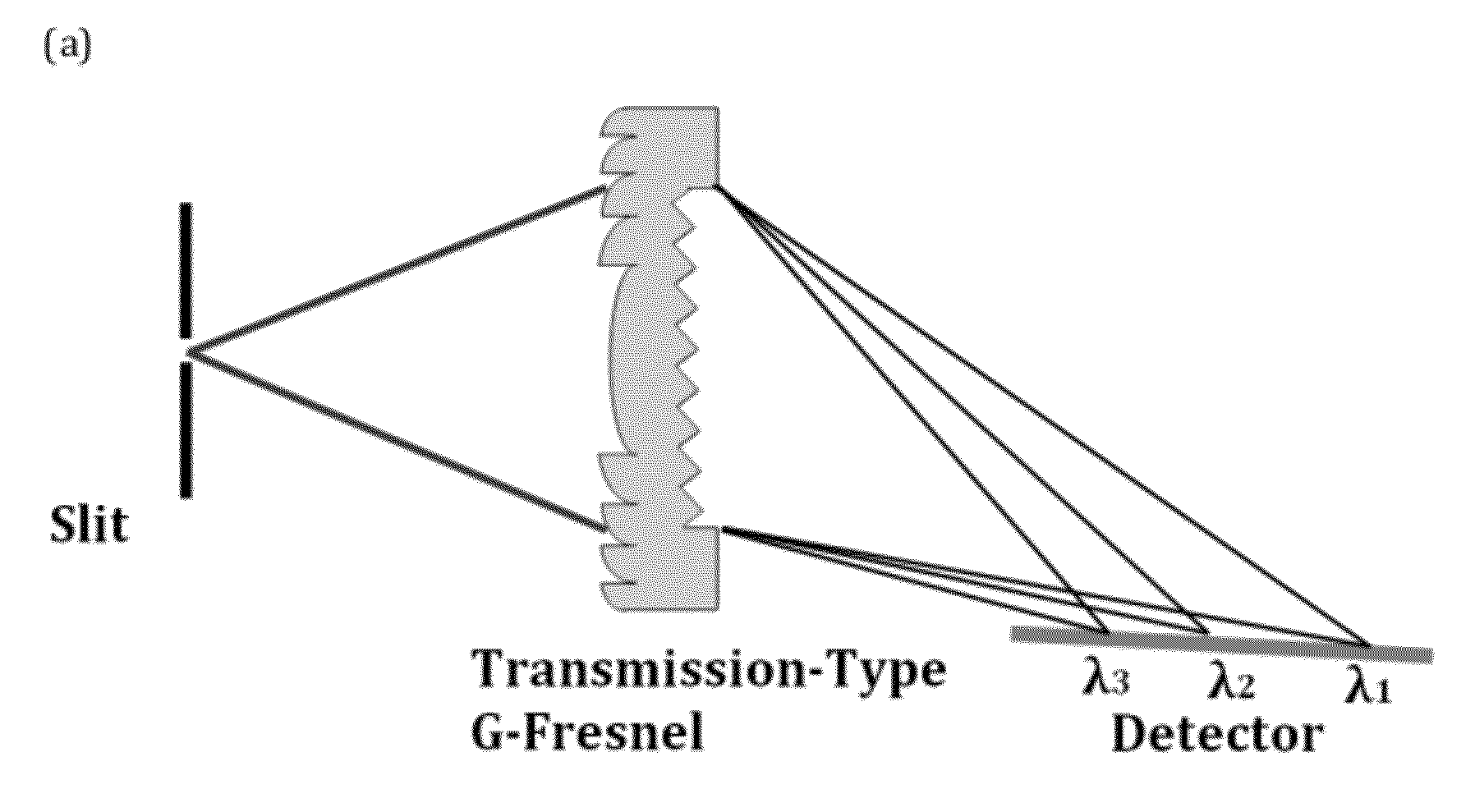Compact Spectrometer Including a Diffractive Optical Element with Dual Dispersion and Focusing Functionality
- Summary
- Abstract
- Description
- Claims
- Application Information
AI Technical Summary
Benefits of technology
Problems solved by technology
Method used
Image
Examples
example 1
Fabrication by PDMS Soft Lithography
[0035]In this example we describe a simple method to fabricate the G-Fresnel device by using PDMS soft lithography. For a general discussion of soft lithography see J. A. Rogers, R. G. Nuzzo, “Recent progress in soft lithography,”Materials Today, 8, 2, 50-56 (2005). The fabrication procedure is illustrated in FIG. 2. Briefly, PDMS pre-polymer mix (Dow Corning, Sylgard-184 PDMS, base to curing agent weight ratio 10:1) is poured onto the surface of a Fresnel lens (c.f. FIG. 2-a, the Fresnel lens is in the bottom). After it is in situ cured at room temperature for two days, a negative Fresnel lens mold is formed and can be peeled off (c.f. FIG. 2-b). FIG. 2 (f) shows a negative Fresnel mold fabricated this way.
[0036]We then sandwich the PDMS pre-polymer between the negative Fresnel mold and a grating (Newport, 300 lines / mm) (c.f. FIG. 2-c). The grating is mounted on a linear translational stage, which can be used to adjust the distance between the tw...
example 2
Theoretical Resolution
[0045]In example 2 we consider a hypothetical transmission-type G-Fresnel diffractive optical element. To achieve a dual functionality of dispersion and focusing, its transmittance is specified by T(x, y)=TG(x, y)TF(x, y), where TG(x, y) represents the transmittance of a constituent grating and TF (x, y) denotes that of a constituent Fresnel lens. Both the grating and the Fresnel lens can be realized by surface relief pattern. Their transmittances are given by
Ti(x,y)=j2πλ(n-1)hi(x,y)(i=GorF)(7)
[0046]in which λ is the wavelength, n is the refractive index of the substrate material, and hG and hF are the respective surface height profiles. The G-Fresnel can be implemented by either placing the grating and the Fresnel lens separately on opposite sides (double-sided), or alternatively, superimposing them in one side of the device (single-sided). FIG. 6 shows the central portion of computer-generated surface profiles of a double-sided G-Fresnel [FIG. 6(a)], and alte...
example 3
Compact Spectrometer
[0051]Example 3 reports the results of a proof-of-concept experimental study to demonstrate the feasibility and functionality of a G-Fresnel based spectrometer. In this example we utilized PDMS soft lithography to fabricate a prototype double-sided transmission-type G-Fresnel. PDMS pre-polymer was poured onto a Fresnel lens (diameter, 2 in. (5 cm); focal length, 100 mm at design wavelength 821 nm). After curing, a negative Fresnel lens mold was obtained. Next, we sandwiched PDMS prepolymer between this negative Fresnel lens mold and a diffraction grating (THORLABS GR25-0310, 300 lines / mm). After it was in situ cured for 48 hours at room temperature, a double-sided transmission-type G-Fresnel was fabricated as shown in FIG. 8(b) with a device area of about 1 in.×1 in. (2.54 cm×2.54 cm).
[0052]A proof-of-concept spectrometer was then built on an optical table as illustrated in FIG. 8(a). It includes an entrance slit, the G-Fresnel [FIG. 8(b)], and a CMOS linear imag...
PUM
 Login to View More
Login to View More Abstract
Description
Claims
Application Information
 Login to View More
Login to View More - R&D
- Intellectual Property
- Life Sciences
- Materials
- Tech Scout
- Unparalleled Data Quality
- Higher Quality Content
- 60% Fewer Hallucinations
Browse by: Latest US Patents, China's latest patents, Technical Efficacy Thesaurus, Application Domain, Technology Topic, Popular Technical Reports.
© 2025 PatSnap. All rights reserved.Legal|Privacy policy|Modern Slavery Act Transparency Statement|Sitemap|About US| Contact US: help@patsnap.com



